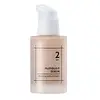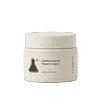What's inside
What's inside
 Key Ingredients
Key Ingredients

 Benefits
Benefits

 Concerns
Concerns

 Ingredients Side-by-side
Ingredients Side-by-side

Avena Sativa Protein Extract
Skin ConditioningWater
Skin ConditioningCyclopentasiloxane
EmollientButylene Glycol
HumectantCetearyl Ethylhexanoate
EmollientCyclohexasiloxane
EmollientPhenyl Trimethicone
Skin ConditioningCetyl PEG/PPG-10/1 Dimethicone
EmulsifyingHydrogenated Poly(C6-14 Olefin)
EmollientNiacinamide
SmoothingPanthenol
Skin Conditioning1,2-Hexanediol
Skin ConditioningGlycerin
HumectantErythritol
HumectantLimnanthes Alba Seed Oil
Skin ConditioningSodium Chloride
MaskingAllantoin
Skin ConditioningEthylhexylglycerin
Skin ConditioningTocopheryl Acetate
AntioxidantAdenosine
Skin ConditioningDextrin
AbsorbentTheobroma Cacao Extract
Skin ConditioningPantolactone
HumectantCeramide NP
Skin ConditioningCholesterol
EmollientPalmitic Acid
EmollientOryza Sativa Seed Protein
AntioxidantStearic Acid
CleansingHydrolyzed Milk Protein
Skin ConditioningLactobacillus Ferment
Skin ConditioningGlycine Soja Protein
EmulsifyingHydrolyzed Lupine Protein
Skin ConditioningGlucose
HumectantHydrolyzed Corn Protein
Skin ConditioningHydrolyzed Rice Protein
Skin ConditioningHydrolyzed Soy Protein
HumectantHydrolyzed Sweet Almond Protein
Skin ConditioningHydrolyzed Vegetable Protein
Skin ConditioningMyristic Acid
CleansingHydrolyzed Pea Protein
EmollientArachidic Acid
CleansingLauric Acid
CleansingSodium Succinate
BufferingDisodium EDTA
Parfum
MaskingAvena Sativa Protein Extract, Water, Cyclopentasiloxane, Butylene Glycol, Cetearyl Ethylhexanoate, Cyclohexasiloxane, Phenyl Trimethicone, Cetyl PEG/PPG-10/1 Dimethicone, Hydrogenated Poly(C6-14 Olefin), Niacinamide, Panthenol, 1,2-Hexanediol, Glycerin, Erythritol, Limnanthes Alba Seed Oil, Sodium Chloride, Allantoin, Ethylhexylglycerin, Tocopheryl Acetate, Adenosine, Dextrin, Theobroma Cacao Extract, Pantolactone, Ceramide NP, Cholesterol, Palmitic Acid, Oryza Sativa Seed Protein, Stearic Acid, Hydrolyzed Milk Protein, Lactobacillus Ferment, Glycine Soja Protein, Hydrolyzed Lupine Protein, Glucose, Hydrolyzed Corn Protein, Hydrolyzed Rice Protein, Hydrolyzed Soy Protein, Hydrolyzed Sweet Almond Protein, Hydrolyzed Vegetable Protein, Myristic Acid, Hydrolyzed Pea Protein, Arachidic Acid, Lauric Acid, Sodium Succinate, Disodium EDTA, Parfum
Avena Sativa Protein Extract
Skin ConditioningDimethicone
EmollientGlycerin
HumectantSqualane
EmollientHydrogenated Polydecene
Emollient1,2-Hexanediol
Skin ConditioningCetyl PEG/PPG-10/1 Dimethicone
EmulsifyingButylene Glycol
HumectantPropanediol
SolventButyrospermum Parkii Butter
Skin ConditioningTapioca Starch
Avena Sativa Kernel Protein
Skin ConditioningSimmondsia Chinensis Seed Oil
EmollientTheobroma Cacao Extract
Skin ConditioningMacadamia Integrifolia Seed Oil
Skin ConditioningOat Amino Acids
Skin ConditioningBifida Ferment Lysate
Skin ConditioningPanthenol
Skin ConditioningMagnesium Sulfate
Water
Skin ConditioningCaprylyl Glycol
EmollientCyclopentasiloxane
EmollientEthylhexylglycerin
Skin ConditioningPentylene Glycol
Skin ConditioningLauryl Polyglyceryl-3 Polydimethylsiloxyethyl Dimethicone
Skin ConditioningTrisodium Ethylenediamine Disuccinate
Beta-Sitosterol
Emulsion StabilisingAluminum Hydroxide
EmollientPolyglyceryl-10 Stearate
Skin ConditioningTriethoxycaprylylsilane
Dextrin
AbsorbentHydrogenated Lecithin
EmulsifyingPolyhydroxystearic Acid
EmulsifyingAluminum Sucrose Octasulfate
Skin ConditioningBrassica Campestris Sterols
EmollientCholesterol
EmollientHydroxyphenyl Propamidobenzoic Acid
Skin ConditioningPhytosteryl/Behenyl/Octyldodecyl Lauroyl Glutamate
Skin ConditioningPolyglyceryl-10 Oleate
Skin ConditioningNeopentyl Glycol Diethylhexanoate
EmollientSodium Surfactin
CleansingCellulose
AbsorbentPentaerythrityl Tetra-Di-T-Butyl Hydroxyhydrocinnamate
AntioxidantTriisopropanolamine
BufferingAscorbyl Palmitate
AntioxidantTocopherol
AntioxidantDisodium EDTA
Titanium Dioxide
Cosmetic ColorantAvena Sativa Protein Extract, Dimethicone, Glycerin, Squalane, Hydrogenated Polydecene, 1,2-Hexanediol, Cetyl PEG/PPG-10/1 Dimethicone, Butylene Glycol, Propanediol, Butyrospermum Parkii Butter, Tapioca Starch, Avena Sativa Kernel Protein, Simmondsia Chinensis Seed Oil, Theobroma Cacao Extract, Macadamia Integrifolia Seed Oil, Oat Amino Acids, Bifida Ferment Lysate, Panthenol, Magnesium Sulfate, Water, Caprylyl Glycol, Cyclopentasiloxane, Ethylhexylglycerin, Pentylene Glycol, Lauryl Polyglyceryl-3 Polydimethylsiloxyethyl Dimethicone, Trisodium Ethylenediamine Disuccinate, Beta-Sitosterol, Aluminum Hydroxide, Polyglyceryl-10 Stearate, Triethoxycaprylylsilane, Dextrin, Hydrogenated Lecithin, Polyhydroxystearic Acid, Aluminum Sucrose Octasulfate, Brassica Campestris Sterols, Cholesterol, Hydroxyphenyl Propamidobenzoic Acid, Phytosteryl/Behenyl/Octyldodecyl Lauroyl Glutamate, Polyglyceryl-10 Oleate, Neopentyl Glycol Diethylhexanoate, Sodium Surfactin, Cellulose, Pentaerythrityl Tetra-Di-T-Butyl Hydroxyhydrocinnamate, Triisopropanolamine, Ascorbyl Palmitate, Tocopherol, Disodium EDTA, Titanium Dioxide
 Reviews
Reviews

Ingredients Explained
These ingredients are found in both products.
Ingredients higher up in an ingredient list are typically present in a larger amount.
1,2-Hexanediol is a synthetic liquid and another multi-functional powerhouse.
It is a:
- Humectant, drawing moisture into the skin
- Emollient, helping to soften skin
- Solvent, dispersing and stabilizing formulas
- Preservative booster, enhancing the antimicrobial activity of other preservatives
We don't have a description for Avena Sativa Protein Extract yet.
Butylene Glycol (or BG) is used within cosmetic products for a few different reasons:
Overall, Butylene Glycol is a safe and well-rounded ingredient that works well with other ingredients.
Though this ingredient works well with most skin types, some people with sensitive skin may experience a reaction such as allergic rashes, closed comedones, or itchiness.
Learn more about Butylene GlycolThis ingredient is a high molecular weight silicone. It has emulsifying and skin conditioning properties.
Cholesterol is a class of organic molecules called lipids. It helps hydrate your skin and is essential to having a healthy skin barrier.
Our skin naturally contains cholesterol in the outermost layer. Besides cholesterol, it also contains ceramides and fatty acids. Cholesterol makes up about 1/4 of your skin's outer layer and barrier. Your skin barrier is responsible for keeping allergens and microbes out. Having a healthy skin barrier is also responsible for keeping your skin firm and plump.
Our bodies use cholestrol to create vitamin D, steroid hormones, and more.
Learn more about CholesterolCyclopentasiloxane, or D5, is a silicone used to improve texture of products and trap moisture.
D5 is considered lightweight and volatile. Volatile means it evaporates quickly after application. Once evaporated, D5 leaves a thin barrier that helps keep skin hydrated.
It is also an emollient. Emollients help soften the skin and prevent water loss. Silicones create a silky texture in products. D5 helps other ingredients become more spreadable.
Studies show D5 is safe to use in skincare products. We recommend speaking with a skincare professional if you have concerns.
Learn more about CyclopentasiloxaneDextrin is used to thicken a product and helps bind ingredients together. It is created from starch and glycogen.
As an emulsifier, dextrin prevents ingredients from separating. This helps elongate a product's shelf life.
Studies show coating UV filters with dextrin prevents these ingredients from being absorbed. This helps UV ingredients last longer on the skin.
Learn more about DextrinDisodium EDTA plays a role in making products more stable by aiding other preservatives.
It is a chelating agent, meaning it neutralizes metal ions that may be found in a product.
Disodium EDTA is a salt of edetic acid and is found to be safe in cosmetic ingredients.
Learn more about Disodium EDTAEthylhexylglycerin (we can't pronounce this either) is commonly used as a preservative and skin softener. It is derived from glyceryl.
You might see Ethylhexylglycerin often paired with other preservatives such as phenoxyethanol. Ethylhexylglycerin has been found to increase the effectiveness of these other preservatives.
Glycerin is already naturally found in your skin. It helps moisturize and protect your skin.
A study from 2016 found glycerin to be more effective as a humectant than AHAs and hyaluronic acid.
As a humectant, it helps the skin stay hydrated by pulling moisture to your skin. The low molecular weight of glycerin allows it to pull moisture into the deeper layers of your skin.
Hydrated skin improves your skin barrier; Your skin barrier helps protect against irritants and bacteria.
Glycerin has also been found to have antimicrobial and antiviral properties. Due to these properties, glycerin is often used in wound and burn treatments.
In cosmetics, glycerin is usually derived from plants such as soybean or palm. However, it can also be sourced from animals, such as tallow or animal fat.
This ingredient is organic, colorless, odorless, and non-toxic.
Glycerin is the name for this ingredient in American English. British English uses Glycerol/Glycerine.
Learn more about GlycerinPanthenol is a common ingredient that helps hydrate and soothe the skin. It is found naturally in our skin and hair.
There are two forms of panthenol: D and L.
D-panthenol is also known as dexpanthenol. Most cosmetics use dexpanthenol or a mixture of D and L-panthenol.
Panthenol is famous due to its ability to go deeper into the skin's layers. Using this ingredient has numerous pros (and no cons):
Like hyaluronic acid, panthenol is a humectant. Humectants are able to bind and hold large amounts of water to keep skin hydrated.
This ingredient works well for wound healing. It works by increasing tissue in the wound and helps close open wounds.
Once oxidized, panthenol converts to pantothenic acid. Panthothenic acid is found in all living cells.
This ingredient is also referred to as pro-vitamin B5.
Learn more about PanthenolThis ingredient is extracted from the seeds of the cocoa tree.
Cacao seeds contain antioxidants known as polyphenols. These include flavonoids, procyanidins, and epicatechins.
Studies show these polyphenols help improve skin health.
The more famous ingredient from cocoa tree is cocoa butter.
Learn more about Theobroma Cacao ExtractWater. It's the most common cosmetic ingredient of all. You'll usually see it at the top of ingredient lists, meaning that it makes up the largest part of the product.
So why is it so popular? Water most often acts as a solvent - this means that it helps dissolve other ingredients into the formulation.
You'll also recognize water as that liquid we all need to stay alive. If you see this, drink a glass of water. Stay hydrated!
Learn more about Water